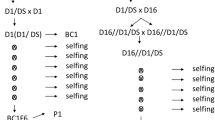Summary
Verticillium wilt is a serious disease of potato and is caused by the soil-borne fungi Verticillium dahliae and V. albo-atrum. No major cultivar is resistant to this disease. Two diploid interspecific potato clones, C287 and C545, were previously identified with consistently high levels of Verticillium wilt resistance and are thought to have the same genotype for the loci that confer resistance to V. dahliae stem colonization. The purpose of this study was to determine whether resistance to V. dahliae stem colonization could be transferred to the tetraploid level in potato via unilateral sexual polyploidization (USP). Progenies in eight families obtained by crossing C287 and C545 to two tetraploid breeding clones, S438 and S440, and the cultivar ‘Atlantic’ were planted in a V. dahliae-infested field and a field without a significant V. dahliae infestation. Resistance was evaluated relative to C545 and C287. There were differences among families for stem colonization and yield. No differences between the mean stem colonization of C545 and C287 progeny were detected. Family differences due to the tetraploid parents indicate that they contributed resistance to the progeny. Stem colonization data from this experiment were consistent with the proposed complementary two-gene model for Verticillium wilt resistance in the diploid parents. Unilateral sexual polyploidization is an effective method for transferring V. dahliae stem colonization resistance to the tetraploid level.
Similar content being viewed by others
References
Akeley, R.V., F.J. Stevenson, D. Folson & R. Bonde, 1956. Breeding varieties of potato resistant to Verticillium wilt in Maine. Am Potato J 33: 15–21.
Butterfield, E.J. & J.E. DeVay, 1977. Reassessment of soil assays for Verticillium dahliae. Phytopathology 67: 1073–1078.
Concibido, V.C., G.A. Secor & S.H. Jansky, 1994. Evaluation of resistance to Verticillium wilt resistance in diploid, wild potato interspecific hybrids. Euphytica 76: 145–152.
Corsini, D.L., J.J. Pavek & J.R. Davis, 1988. Verticillium wilt resistance in noncultivated tuber-bearing Solanum species. Plant Dis 72: 148–151.
Davis, J.R., 1981. Verticillium wilt of potato in southeastern Idaho. In University of Idaho Current Information Series Number 564.
DeJong, H., L.M. Kawchuk, W.K. Coleman, C.A. Verhaeghe, L. Russell, V.J. Burns & E. Tremblay-Deveau, 2001. Development and characterization of an adapted form of droopy, a diploid potato mutant deficient in abscisic acid. Am J Potato Res 78(4): 279–290.
Hermundstad, S. & S.J. Peloquin, 1986. Tuber yield and tuber traits of haploid-wild species F1 hybrids. Potato Res 29: 289–297.
Herriott, A.B., J.F.L. Haynes & P.B. Shoemaker, 1990. Inheritance of resistance to early blight in tetraploid× diploid crosses of potatoes. Hortscience 25(2): 224–226.
Hougas, R.W. & S.J. Peloquin, 1960. Crossability of Solanum tuberosum haploids with diploid Solanum species. Eur Potato J 3: 325–330.
Hunter, D.E., H.M. Darling, F.J. Stevenson & C.E. Cunningham, 1968. Inheritance of resistance to Verticillium in Wisconsin. Am Potato J 45: 72–78.
Iwanaga, M., P. Jatala, R. Ortiz & E. Guevara, 1989. Use of FDR 2n pollen to transfer resistance to root-knot nematodes into cultivated 4x potatoes. J Am Soc Hortic Sci 114(6): 1008–1013.
Jansky, S.H., P.J. Kauth & D.I. Rouse, 2004. Inheritance of resistance to Verticillium dahliae in diploid interspecific potato hybrids. Plant Dis 88(10): 1075–1078.
Jansky, S.H. & D.I. Rouse, 2000. Identification of potato interspecific hybrids resistant to Verticillium wilt and determination of criteria for resistance assessment. Potato Res 43: 413–426.
Jansky, S.H. & D.I. Rouse, 2003. Multiple disease resistance in interspecific hybrids of potato. Plant Dis 87: 266–272.
Lynch, D.R., L.M. Kawchuk, J. Hachey, P.S. Bains & R.J. Howard, 1997. Identification of a gene conferring high levels of resistance to Verticillium wilt in Solanum chacoense. Plant Dis 81: 1011–1014.
Marks, G.E., 1966. The origin and significance of intraspecific polyploidy: experimental evidence from Solanum chacoense. Evolution 20: 552–557.
McLean, J.G., 1955. Selecting and breeding potatoes for field resistance to Verticillium wilt in Idaho. Idaho Agricultural Experiment Station Research Bulletin 30: 1–19.
Mendiburu, A.O. & S.J. Peloquin, 1976. Sexual polyploidization and depolyploidization: Some terminology and definitions. Theor Appl Genet 48: 137–143.
Murphy, A.M., H.D. Jong & G.C.C. Tai, 1995. Transmission of resistance to common scab from the diploid to the tetraploid level via 4x× 2x crosses in potatoes. Euphytica 82: 227–233.
Ortiz, R., 1998. Potato breeding via ploidy manipulations. Plant Breed Rev 16: 15–86.
R-Development-Core-Team, 2004. R: A language and environment for statistical computing 1.7. R Foundation for Statistical Computing.
Rouse, D.I., 1985. Some approaches to prediction of potato early dying disease severity. Am Potato J 62: 187–193.
Rowe, R.C., 1985. Potato early dying: a serious threat to the potato industry. Am Potato J 62: 157–161.
Rowe, R.C., J.R. Davis, M.L. Powelson & D.I. Rouse, 1987. Potato early dying: causal agents and management strategies. Plant Dis 71: 482–489.
Sanford, J.C. & R.E. Hanneman, Jr, 1979. Reciprocal differences in the photoperiod reaction of hybrid populations in Solanum tuberosum. Am Potato J 56: 531–540.
Tung, P.X., E.T. Rasco, P. Vander Zaag, Jr. & P. Schmiediche, 1990. Resistance to Pseudomonas solanacearum in the potato: 1. Effects of sources of resistance and adaptation. Euphytica 45: 203–210.
Watanabe, K., H.M. El-Nashaar & M. Iwanaga, 1992. Transmission of bacterial wilt resistance by First Division Restitution (FDR) 2n pollen via 4x× 2x crosses in potatoes. Euphytica 60: 21–26.
Author information
Authors and Affiliations
Rights and permissions
About this article
Cite this article
Frost, K.E., Jansky, S.H. & Rouse, D.I. Transmission of Verticillium wilt resistance to tetraploid potato via unilateral sexual polyploidization. Euphytica 149, 281–287 (2006). https://doi.org/10.1007/s10681-005-9076-1
Received:
Accepted:
Published:
Issue Date:
DOI: https://doi.org/10.1007/s10681-005-9076-1




